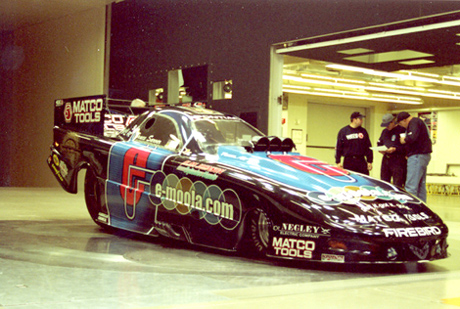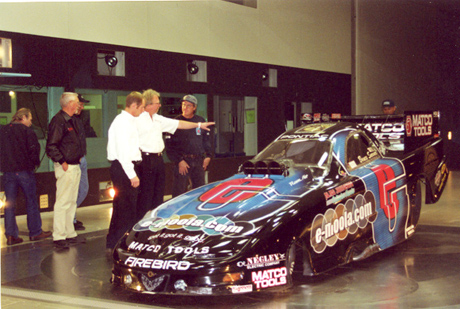The General Motors Technical Center is located on a one-square mile piece
of real estate in Warren, Michigan. Inside its heavily secured fences
sits an unassuming building called the GM Aeronautical Laboratory, also
known as the "Wind Tunnel."
The Aero Lab runs three eight-hour shifts, 24 hours a day, six days
a week. It is here that General Motors sends its extensive line of cars
and trucks through a comprehensive series of tests in order to produce
the most aerodynamically efficient vehicles on the market. Information
gathered here is transferred to the consumer in the form of lower fuel
costs and quieter, safer automobiles.

It's Wednesday morning. But today there's a buzz in the air and a
little more excitement than usual for the engineers in attendance. Instead
of running a GMC Envoy or Pontiac Bonneville through its aerodynamic
paces, the NHRA Pontiac Firebird Funny Car driven by Bruce Sarver is
being clamped down onto the chamber platform for the 8 a.m. shift.
"The GM Aero Lab provides our race teams with a resource that is staffed
by engineers and technicians with many years of experience in drag,
oval track and road racing," said Harry Turner, GM Engineering Group
Manager, NHRA Drag Racing. "The extensive technological support provided
by our engineers is something that you just can't buy."
During a competitive run on the 24-event NHRA Winston championship
circuit the objective is to traverse a quarter-mile in the least amount
of time possible. Maximum downforce and minimum drag on a nitro-powered
Funny Car help to achieve that goal. Working in conjunction with the
proper amount of horsepower, the aerodynamics of a Pontiac Firebird
Funny Car allow it to reach speeds in excess of 320 mph in less than
4.9 seconds. Although the crossover from the aero lab to the racetrack
is never identical, the wind tunnel lets GM engineers closely simulate
racetrack conditions while giving Sarver, his crew chief Richard Hogan
and team owner Alan Johnson data they can use to improve their racecar.

|